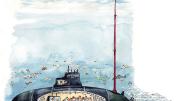1935
Director of athletics William J. Bingham states in the Crimson that if the German government persists in its policy of excluding Jewish athletes from the 1936 Olympic Games in Berlin, Harvard will not be represented on the American team.
1950
The newly opened, $3-million Graduate Center, designed by Walter Gropius and The Architects Collaborative, houses 575 students in seven new dorms and can feed 1,200 students per meal in the new Harkness Commons.
1960
Crew members of the Polaris-missile-armed submarine USS George Washington become the first students allowed to take a Harvard extension course outside the Boston area. Crane Brinton’s lectures for “The Anatomy of Revolution,” one of the first extension courses given for television credit, have been recorded for undersea viewing; once back in port, students will have class sessions with a teaching fellow before the final exam.
1970
A powerful bomb explodes early in the morning inside the Center for International Affairs, causing property damage but no injuries. More than 20 bomb scares in University buildings had been recorded in the previous 13 months, but no bombing had occurred at Harvard since rebellious students set off an explosion at morning chapel in 1834.
1990
A Women’s Center for undergraduates opens in Radcliffe Yard with the help of a grant from Harvard. Radcliffe president Linda Wilson stresses that the new center must be welcoming to both men and women and “an intergenerational and interdisciplinary gathering place.”
2000
An “extremely modest” notice in the September 24 New York Times announces an opening for “President, Harvard University.” Applicants should be persons of “high intellectual distinction and demonstrated leadership qualities.”
The Law School’s first Celebration of Black Alumni draws some 600 of the more than 1,500 graduates invited. The weekend witnesses the conferral of the first Harvard Law School Medal of Freedom on 12 surviving members or relatives of the Brown v. Board of Education litigation team.









